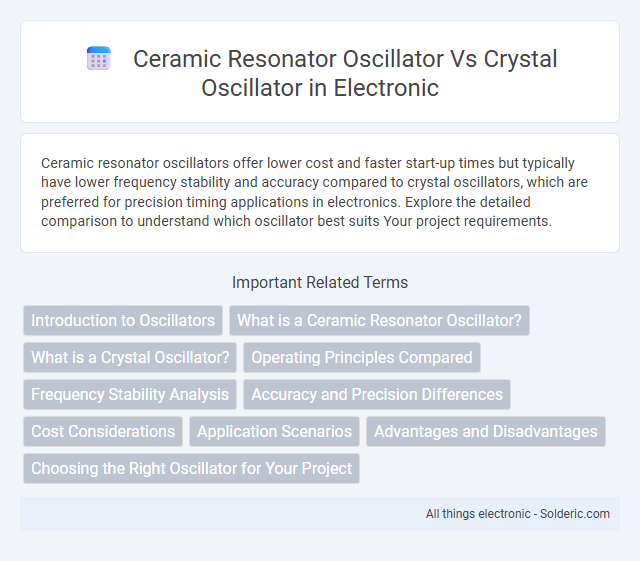Ceramic resonator oscillators offer lower cost and faster start-up times but typically have lower frequency stability and accuracy compared to crystal oscillators, which are preferred for precision timing applications in electronics. Explore the detailed comparison to understand which oscillator best suits Your project requirements.
Comparison Table
| Feature | Ceramic Resonator Oscillator | Crystal Oscillator |
|---|---|---|
| Frequency Stability | Moderate (+-0.5% to +-0.01%) | High (+-10 ppm to +-50 ppm) |
| Frequency Range | 1 MHz to 30 MHz | 1 kHz to 200 MHz |
| Cost | Low | Higher |
| Size | Smaller, compact | Generally larger |
| Temperature Sensitivity | Higher | Low |
| Quality Factor (Q) | Lower (~100 to 1000) | Very High (~10,000 to 100,000) |
| Applications | Consumer electronics, automotive, timing in microcontrollers | Precision clocks, communication systems, instrumentation |
| Start-up Time | Faster | Slower |
| Long-term Stability | Lower | High |
Introduction to Oscillators
Ceramic resonator oscillators and crystal oscillators serve as essential timing devices in electronic circuits by generating precise frequency signals. Ceramic resonators offer lower cost and faster startup times but typically have lower frequency stability and accuracy compared to crystal oscillators, which provide superior precision due to the piezoelectric properties of quartz crystals. Both types are widely used in microcontrollers, communication devices, and timing circuits, balancing trade-offs between performance, cost, and size.
What is a Ceramic Resonator Oscillator?
A Ceramic Resonator Oscillator is an electronic component that uses piezoelectric ceramic material to generate stable oscillation frequencies in circuits, primarily for timing applications. It offers faster start-up times and better resistance to mechanical shock compared to crystal oscillators, making it suitable for automotive and consumer electronics. Ceramic resonators typically provide lower frequency stability and precision than quartz crystal oscillators but are more cost-effective for less critical applications.
What is a Crystal Oscillator?
A Crystal Oscillator is an electronic circuit that uses the mechanical resonance of a vibrating quartz crystal to create an accurate frequency signal. It offers high frequency stability and low phase noise, making it essential for precise timing applications in microcontrollers, communication devices, and clocks. Your choice of oscillator directly impacts the accuracy and reliability of your electronic systems.
Operating Principles Compared
Ceramic resonator oscillators use piezoelectric ceramic materials to generate oscillations through mechanical vibrations at specific frequencies, offering faster start-up times and lower cost compared to crystal oscillators. Crystal oscillators rely on the precise mechanical resonance of quartz crystals to maintain highly stable and accurate frequency output, making them ideal for applications requiring tight frequency control. Your choice depends on the need for frequency stability versus cost-efficiency and response time in the oscillator circuit.
Frequency Stability Analysis
Ceramic resonator oscillators offer moderate frequency stability, typically around +-0.5% due to their temperature-dependent characteristics, making them suitable for less demanding timing applications. Crystal oscillators provide superior frequency stability, often within +-10 ppm, because of their precise quartz crystal properties and lower sensitivity to environmental changes. The stability of crystal oscillators supports high-precision requirements in communication systems and instrumentation, whereas ceramic resonators are a cost-effective alternative when extreme accuracy is not critical.
Accuracy and Precision Differences
Ceramic resonator oscillators exhibit lower accuracy and precision compared to crystal oscillators due to their broader frequency tolerance and higher temperature sensitivity. Crystal oscillators maintain frequency stability within +-10 ppm or better, making them ideal for applications requiring exact timing. Your choice depends on whether cost efficiency and moderate precision suffice or if high-accuracy timing is crucial for the system's performance.
Cost Considerations
Ceramic resonator oscillators typically offer a lower cost solution compared to crystal oscillators due to their simpler manufacturing process and use of less expensive materials. While crystal oscillators provide superior frequency stability and precision, their higher cost makes ceramic resonators a preferred choice in budget-sensitive applications where ultra-high accuracy is not critical. Cost considerations often drive the selection between these oscillators in consumer electronics, automotive controls, and embedded systems.
Application Scenarios
Ceramic resonator oscillators are commonly used in cost-sensitive applications such as consumer electronics, automotive systems, and microcontroller clock generation due to their moderate frequency stability and low cost. Crystal oscillators excel in precision-demanding scenarios like communication systems, GPS devices, and high-frequency measurement equipment, offering superior frequency accuracy and long-term stability. Both components serve distinct roles depending on requirements for stability, frequency tolerance, and cost constraints in embedded systems design.
Advantages and Disadvantages
Ceramic resonator oscillators offer advantages such as lower cost, smaller size, and faster start-up times compared to crystal oscillators, making them suitable for applications requiring moderate frequency stability. However, they exhibit higher frequency tolerance and lower quality factors, resulting in less precise frequency control and increased phase noise. Crystal oscillators provide superior frequency stability, accuracy, and lower phase noise due to their high Q-factor, but they are typically more expensive, larger, and have longer start-up times.
Choosing the Right Oscillator for Your Project
When choosing the right oscillator for your project, consider that ceramic resonator oscillators offer cost-effective, compact solutions with moderate frequency stability suitable for general applications. Crystal oscillators provide superior frequency accuracy and stability, making them ideal for high-precision tasks such as communications and instrumentation. Evaluating your project's requirements for frequency tolerance, environmental conditions, and budget will guide you in selecting the optimal oscillator type.
Ceramic resonator oscillator vs Crystal oscillator Infographic

 solderic.com
solderic.com